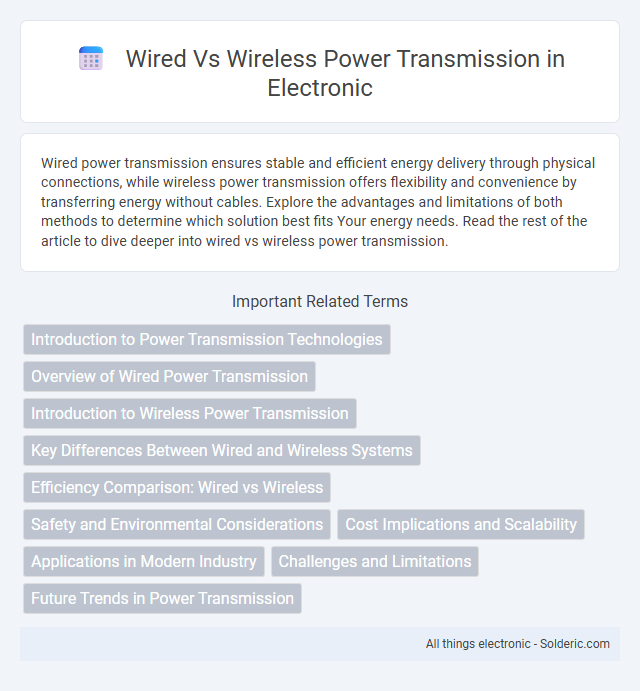Wired power transmission ensures stable and efficient energy delivery through physical connections, while wireless power transmission offers flexibility and convenience by transferring energy without cables. Explore the advantages and limitations of both methods to determine which solution best fits Your energy needs. Read the rest of the article to dive deeper into wired vs wireless power transmission.
Comparison Table
| Aspect | Wired Power Transmission | Wireless Power Transmission |
|---|---|---|
| Definition | Transfer of electrical energy via physical conductors (wires, cables) | Transfer of electrical energy without physical contact, via electromagnetic fields |
| Efficiency | High efficiency (up to 95%+) | Moderate to low efficiency (typically 40%-85%) depending on range and technology |
| Range | Unlimited within wired connection limits | Short to medium range (millimeters to several meters) |
| Installation | Requires physical wiring, panels, and infrastructure | No wiring needed; requires transmitters and receivers |
| Mobility | Limited by wires | Enables device mobility and convenience |
| Applications | Household wiring, industrial grids, electronic devices | Wireless charging pads, implantable medical devices, IoT sensors |
| Safety | Low risk if insulated properly; risk of electric shock exists | Generally safe; minimal risk when designed within standards |
| Cost | Lower component cost; higher installation cost | Higher component cost; lower installation cost |
Introduction to Power Transmission Technologies
Power transmission technologies enable the transfer of electrical energy from a source to a load through either wired or wireless methods, each with distinct advantages and limitations. Wired power transmission relies on conductive cables, offering high efficiency and stability for long-distance and high-power applications, while wireless power transmission uses electromagnetic fields or radio waves to deliver power without physical connectors, enhancing convenience and mobility. Understanding these technologies helps you select the optimal power delivery system tailored to specific needs, whether for consumer electronics, industrial machinery, or emerging smart devices.
Overview of Wired Power Transmission
Wired power transmission involves the transfer of electrical energy through physical conductors such as copper or aluminum cables, ensuring high efficiency and minimal energy loss over short to medium distances. This method dominates in conventional power distribution systems and is essential for providing stable and reliable electricity to residential, commercial, and industrial sectors. High-voltage transmission lines utilize step-up transformers to reduce current and limit resistive losses, optimizing the performance of wired power networks.
Introduction to Wireless Power Transmission
Wireless power transmission uses electromagnetic fields to transfer energy without physical connectors, enabling efficient charging and powering of devices over varying distances. Technologies such as inductive coupling, resonant inductive coupling, and microwave transmission offer flexible and convenient alternatives to traditional wired systems. This innovation supports seamless integration in applications from consumer electronics to electric vehicles and implantable medical devices.
Key Differences Between Wired and Wireless Systems
Wired power transmission relies on physical conductors like cables or wires to transfer electrical energy, ensuring high efficiency and minimal power loss over short to moderate distances. Wireless power transmission uses electromagnetic fields or radio waves, enabling energy transfer without physical connections but often experiencing higher energy loss and limited range. Key differences include efficiency, distance capabilities, installation complexity, and application suitability, with wired systems favoring fixed infrastructure and wireless systems offering mobility and convenience.
Efficiency Comparison: Wired vs Wireless
Wired power transmission typically achieves efficiency rates above 90%, owing to minimal energy loss through direct conductive paths. Wireless power transmission efficiency varies significantly based on distance and technology, ranging from 40% to 80% for short-range inductive systems and dropping below 50% for long-range methods like microwave or laser transmission. The inherent resistive losses in cables and electromagnetic radiation losses in wireless systems dictate these efficiency disparities.
Safety and Environmental Considerations
Wired power transmission systems generally offer higher safety due to their controlled and enclosed infrastructure, minimizing exposure to electromagnetic fields and reducing the risk of electric shock or fire hazards. Wireless power transmission involves exposure to electromagnetic radiation, which requires strict regulation and safety standards to prevent potential health risks and interference with other electronic devices. Environmentally, wireless systems reduce the need for physical cables and associated materials, which can lower resource consumption and waste, but they may increase energy loss during transmission compared to wired solutions.
Cost Implications and Scalability
Wired power transmission generally incurs lower initial costs due to established infrastructure and standardized components but faces higher expenses in lengthy or complex installations. Wireless power transmission demands significant investment in advanced technology and power conversion systems, driving up upfront costs, yet offers superior scalability for dynamic or hard-to-wire environments. Scalability in wireless systems benefits from ease of deployment and adaptability, while wired systems require extensive planning and resource allocation for network expansion.
Applications in Modern Industry
Wired power transmission remains essential in applications requiring stable, high-capacity energy delivery, such as manufacturing plants and data centers, ensuring consistent performance and minimal energy loss. Wireless power transmission is increasingly adopted in industries like electric vehicle charging, wearable technology, and medical implants, offering flexibility and convenience without physical connectors. Your choice between wired and wireless solutions depends on factors like transmission distance, power requirements, and the need for mobility or fixed installations.
Challenges and Limitations
Wired power transmission faces challenges such as energy loss due to resistance in cables and limited flexibility in installation, restricting mobility and scalability. Wireless power transmission encounters significant limitations including reduced efficiency over distance, susceptibility to interference, and safety concerns related to electromagnetic exposure. Both methods require advancements in materials and technology to overcome these constraints and improve overall energy transfer performance.
Future Trends in Power Transmission
Future trends in power transmission emphasize advancements in wireless technology, enabling more efficient and flexible energy delivery without physical connections. Wireless power transmission leverages resonant inductive coupling and microwave transmission to support smart grids and IoT devices, revolutionizing how power is distributed and consumed. You can expect greater integration of hybrid systems combining wired reliability with wireless convenience, enhancing sustainability and grid resilience.
Wired vs Wireless Power Transmission Infographic

 solderic.com
solderic.com